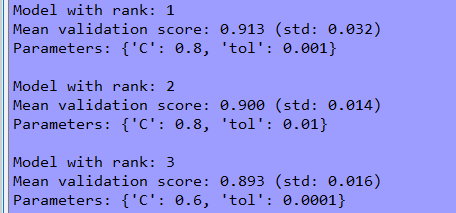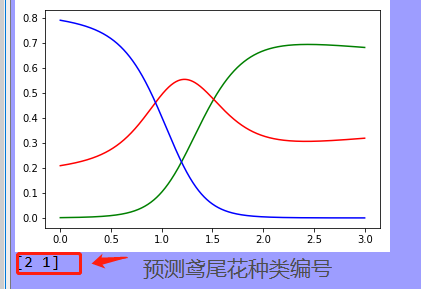代码实现(基于逻辑回归算法):
1 # -*- coding: utf-8 -*- 2 """ 3 Created on Sat Sep 1 11:54:48 2018 4 5 @author: zhen 6 7 交叉验证 8 """ 9 import numpy as np 10 from sklearn import datasets 11 from sklearn.linear_model import LogisticRegression 12 from sklearn.model_selection import GridSearchCV 13 import matplotlib.pyplot as plt 14 15 iris = datasets.load_iris() 16 x = iris['data'][:, 3:] 17 y = iris['target'] 18 19 20 def report(results, n_top=3): 21 for i in range(1, n_top + 1): 22 candidates = np.flatnonzero(results['rank_test_score'] == i) 23 for candidate in candidates: 24 print("Model with rank: {0}".format(i)) 25 print("Mean validation score: {0:.3f} (std: {1:.3f})".format( 26 results['mean_test_score'][candidate], 27 results['std_test_score'][candidate])) 28 print("Parameters: {0}".format(results['params'][candidate])) 29 print("") 30 31 32 param_grid = {"tol":[1e-4, 1e-3,1e-2], "C":[0.4, 0.6, 0.8]} 33 34 log_reg = LogisticRegression(multi_class='ovr', solver='sag') 35 # 采用3折交叉验证 36 grid_search = GridSearchCV(log_reg, param_grid=param_grid, cv=3) 37 grid_search.fit(x, y) 38 39 report(grid_search.cv_results_) 40 41 x_new = np.linspace(0, 3, 1000).reshape(-1, 1) 42 y_proba = grid_search.predict_proba(x_new) 43 y_hat = grid_search.predict(x_new) 44 45 plt.plot(x_new, y_proba[:, 2], 'g-', label='Iris-Virginica') 46 plt.plot(x_new, y_proba[:, 1], 'r-', label='Iris-Versicolour') 47 plt.plot(x_new, y_proba[:, 0], 'b-', label='Iris-Setosa') 48 plt.show() 49 50 print(grid_search.predict([[1.7], [1.5]]))
结果:


总结:使用交叉验证可以实现代码自动对设定范围参数的模型进行分别训练,最后选出效果最好的参数所训练出的模型进行预测,以求达到最好的预测效果!